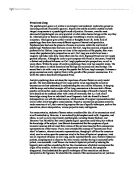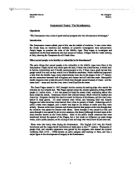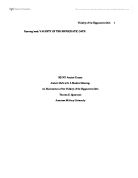Breathlessness in patients with advanced cancer.
Tutorial Presentation: Breathlessness in patients with advanced cancer Aim Breathlessness is a common and difficult problem in advanced cancer. It can completely dominate a patient's life, causing physical disability, loss of independence and dignity and lowered self esteem. Breathlessness in cancer patients is seen as a distressing symptom, influenced by physical, psychological, emotional and social factors. The audience will gain awareness of the major causes of breathlessness and how it can be managed efficiently by the patient, their families and health care professional to maintain and promote quality of life. Thus, this presentation will enlighten the audience of the effects that breathlessness on patients with advanced cancer has on their physical, psychosocial and financial lifestyle. Overview This tutorial presentation will discuss the following key points: - Definition of breathlessness - Major causes of breathlessness - Symptoms and signs of breathlessness - Consequences of breathlessness and their influence on the patients lifestyle - Assessment of breathlessness - Management of breathlessness - Ways of coping with breathlessness Definition of breathlessness There are many definitions that describe breathlessness or dyspnoea. The Australian Nurses' Dictionary defines breathlessness as "difficult or laboured breathing", whereas concerned patients
Clinicians have ethical codes, should scientists have them too?
Clinicians have ethical codes, should scientists have them too? Sir Joseph Rotblat, who first championed the call for a moral code of conduct directed at scientists, premised his ideas upon the foundations of the Hippocratic Oath1. Pertaining to the ethical practice of medicine and taken by graduates of medical school, the oath was designed, in part, to recognise the duty that the doctor has to the patient; to safeguard the autonomy, freedom from discrimination and standard of healthcare that the patient receives. In an age of rapidly progressing scientific development, limited largely only by vision and time, it must be considered that, as the doctor has a duty to his patient perhaps so too does the scientist have an obligation to the scientific community and society as a whole. Moreover, as public mistrust of the scientific world continues to grow, stimulated by incidents such as Wakefield et al study into the MMR vaccine, it seems increasingly necessary to formalize a code of conduct aimed at encouraging integrity and good practice whilst at the same time fostering an understanding of ethical and moral awareness2,3. To this end, a form of ethical code could provide a framework, inside of the law, from which scientists would operate within and would also provide guidance and consideration on matters upon which the scientist has an obligation to and an impact upon, direct or
Freud and Jung
Freud and Jung The psychological genre as it relates to sociological and medicinal matters has gained an increasing amount of scientific approval. Impartiality and the scientific method are both integral components to a psychologist's mode of practice. However, even the most esteemed of psychologists can only speculate at what makes human beings act the way they do. Absolutes play no function in psychology. Everything is relative and open to conjecture. Theologians give us their visions or thoughts about life. In the field of psychology, there have been many different regions of interest and speculation. Psychoanalysis has been the pinnacle of arenas to examine within the vast field of psychology. Psychoanalysis has been an area that Carl Jung has explored, critiqued and perfected in his lifetime. Jung was not alone in his exploration of the psyche; there were many other psychoanalytic perspectives as well. Carl Jung was said to have been a magnetic individual who drew many others into his circle. Sigmund Freud was Carl Jung's greatest influence. Although he came to part company with Freud in later years, Freud had a distinct and profound influence on Carl Jung's psychoanalytic perspectives, as well as many others. Within the scope of analytic psychology, there exist two essential tenets. The first is the system in which sensations and feelings are analyzed and listed by
Stressors and coping mechanisms: a variation in gender, adolescence and ethnic identity.
Final year project Stressors and coping mechanisms: a variation in gender, adolescence and ethnic identity. Introduction Stress is something that is experienced by everyone at some stage in his or her life. It is our body's response to any stimulus and any type of stress can trigger a physiological response. Although there are many definitions of stress (see Selye, 1956; Goestsch and Fuller, 1995; Cohen, Kessler & Gordon, 1995), a widely applied definition of psychological stress is that of Lazarus and Folkman (1984). These authors define stress as: "...a relationship between the person and the environment that is appraised by the person as taxing or exceeding his or her personal resources and endangering his or her well being" (Lazarus and Folkman, 1984. P.21). Lazarus and Folkman emphasise the relationship between people and their surroundings, while simultaneously considering the characteristics and resources inherent in both the individual and their environment. As a result it can be argued that the definition is ecological in it perspective. Things that create stress are called stressors. Stressors can be external-as a result of the environment or internal-in your mind. For something to be stressful, the event must be threatening to the individual in someway (Bird & Harris, 1990). For example, losing a close family member can be threatening. A situation that is not
The Renaissance was a time of good medical progress but very few practical advantages
Assessment Essay: The Renaissance. Hypothesis "The Renaissance was a time of good medical progress but very few practical advantages." Introduction The Renaissance means rebirth, part of this was the rebirth of medicine. It was a time when the Greek ideas on medicine and methods of scientific investigation were rediscovered. People began to question the rules of the Middle Ages. They began to investigate and experiment for the best treatments and real causes of disease. It began with the Arabs coming to Italy, showing the Europeans the old Greek ideas. What caused people to be healthy or unhealthy in the Renaissance? The same things that caused people to be unhealthy in the Middle Ages were there in the Renaissance. People relied very much upon the land, if there was a bad harvest, it would lead to famine, malnutrition and ill health causing people to die. If there was a good harvest then people would live well as they would live in healthier conditions. Public health had improved a little from the Middle Ages, most improvements were due to the plague in the 17th century but the connection between lack of hygiene and disease had still not been made. Most public health measures were to take the smell (which they thought caused disease) of waste - and the waste itself - away and into the river, were it would pollute the water. The Great Plague started in 1665, brought
The Birth of Midwifery.
The Birth of Midwifery As women gave birth, they sought and received care from supportive others. At an unknown point in the cultural evolution, some experienced women became designated as the wise women to be in attendance at birth. Thus, the profession of midwifery began. Indeed, as historians have noted, midwifery has been characterized as a social role throughout recorded history, regardless of culture or time. Biblical recognition of the functions of midwives included several verses recounting the experiences of two Hebrew midwives who refused to kill male infants in defiance of the King of Egypt (Exodus 1:15-22). Other verses in the Bible also make passing references to midwifery attendance at birth, implying that it was ubiquitous (Genesis 35:17; 38:28). Historians have found the practice of midwifery referred to in other papyri as well as in ancient Hindu records. In Greek and Roman times, midwives functioned as respected, autonomous care providers to women during their reproductive cycles. Some qualifications for the practice of midwifery began to evolve during this period. For example, in Greece the midwife was a woman who had born children herself. This requirement has remained a commonality in the practice of midwifery throughout several cultures and exists even today. "Midwife" is a word which in English was translated to mean "with woman", implying the
Ancient Oath with A Modern Meaning: An Examination of the Validity of the Hippocratic Oath.
Validity of the Hippocratic Oath 1 Running head: VALIDITY OF THE HIPPOCRATIC OATH HS 301 Ancient Greece Ancient Oath with A Modern Meaning: An Examination of the Validity of the Hippocratic Oath Thomas G. Spearman American Military University Validity of the Hippocratic Oath 2 One of the major changes to emerge out of the Greek Classical period was that of scientific inquiry into physical phenomenon. It occurred when Hippocrates embarked on a career in the healing arts over 2,400 years ago. His methods were decidedly scientific, relying upon observations which, when collated and analyzed, led to certain actions that could benefit patients. This was a watershed event in that it relied upon the cause and effect theory, rather than consultation of oracles or entreaties to gods for healing. Right and correct actions lead to positive and desirable results. This method made Hippocrates the innovator of his day. One innovation that stands out in particular was the creation of an oath that encompassed the practice of medical ethics. It wasn't the first code of medical ethics, but it certainly was and still is, the longest lasting. (Hammurabi, a Babylonian king, was probably the first; he devised a code that determined how many shekels were to be paid for physician services and which part of their bodies would be amputated if they killed the patient!)
The Vulnerable Population of Alcoholics
Running head: ALCOHOL ABUSERS The Vulnerable Population of Alcohol Abusers Lee Ranalli Arizona State University The Vulnerable Population of Alcohol Abusers Introduction I chose the vulnerable population of people who abuse alcohol because of the history of this type of abuse in my family and my own personal drive of wanting to learn more about it. The main subject I was looking forward to learn more about was comparing the findings on researched family dynamics to my own childhood family dynamics involved with alcoholism. I have learned time and time again about all the genetic factors and the specific science of alcoholism but I thought it might be nice change of pace to research the bigger picture of the effects of this disease and not so much the disease itself. In this paper, alcohol abuse and alcoholism are similar terms but with different definitions. Alcohol abuse will be defined as "pattern of drinking that results in harm to one's health, interpersonal relationships or ability to work" ("What is the Difference", 2006). This includes involving oneself in risky behavior such as drinking and driving, being irresponsible such as missing school and work, and has the potential to eventually lead to alcoholism ("What is the Difference", 2006). Alcoholism will be defined as a disease that can be diagnosed by looking at a variety of components including "a strong
How far did the sick rely on written communications in looking for remedies in England, 1375-1640?
How far did the sick rely on written communications in looking for remedies in England, 1375-1640? When someone became sick in England between 1375 and 1640 the number of options they had for seeking remedies depended largely on their illness and their resources. Some of these options centred or relied on written communications, however, others made use of different types. "Lay people moved easily between the medicine provided by a poor old woman, by empirics and by learned medicine" (Wear 2000). For nearly everyone though during this period care began at home and was largely the responsibility of the woman of a household. The means for women in this position to collect relevant information varied from oral tradition and example, to recipe books and even vernacular texts aimed at their readership. Familial and friendly resources exhausted, a sick person might turn to one of the many unlicensed medical practitioners who frequented towns and the country side. Remedies could be sought from wise old women to mountebanks, and again, the source of their knowledge, and their means of selling their remedies could sometimes rely on written communications. 'Qualified' medical practitioners might include apothecaries from whom medicines could be bought, though often physicians tried to limit this trade. Usually a last resort, and only available to a small proportion of the
Religion was a hindrance to the development of medicine in the Middle Ages. - Discuss
Examen: Religion was a hindrance to the development of medicine in the Middle Ages. Religion in the Middle Ages was not entirely a hindrance to the development of medicine. In some ways it improved it but also held back the development. I shall discuss Christianity and Islam (as they were the leading religions) to support this. When the Roman Empire collapsed very few organisations were left. One of these was the Christian church. Christianity hindered the development of medicine because priests said that God caused sickness and faith, saints and prayer seemed effective cures. They also relied on charms and herbal remedies. They believed that "to buy drugs and consult with physicians doesn't fit with religion". Because of this there was hardly any study of medicine or training of doctors in Christian Europe until 1200. The development of medicine was hindered because the Christian religion did not allow them to buy drugs and believed that religious ways were more effective cures. In 1200 Universities were built and controlled by the Church. This meant teachings were according to the Bible and other medical books such as Galens (Galen's religious beliefs also restricted him as he could not dissect a human body. To find out more he dissected animals and believed in these findings. However some were incorrect, as most animals are different to humans). Scholars there did not











